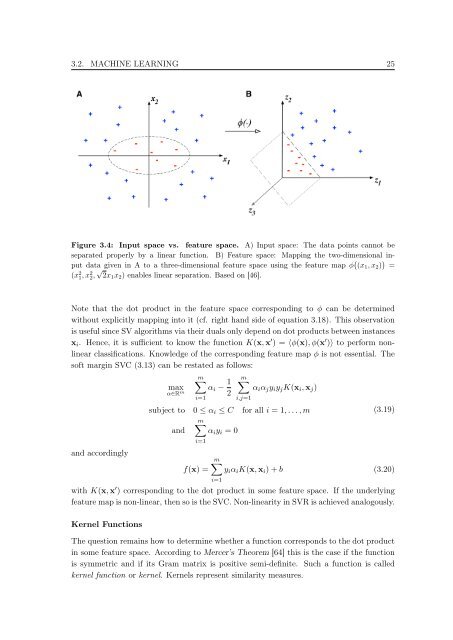New Approaches to in silico Design of Epitope-Based Vaccines
New Approaches to in silico Design of Epitope-Based Vaccines
New Approaches to in silico Design of Epitope-Based Vaccines
Create successful ePaper yourself
Turn your PDF publications into a flip-book with our unique Google optimized e-Paper software.
3.2. MACHINE LEARNING 25<br />
Figure 3.4: Input space vs. feature space. A) Input space: The data po<strong>in</strong>ts cannot be<br />
separated properly by a l<strong>in</strong>ear function. B) Feature space: Mapp<strong>in</strong>g the two-dimensional <strong>in</strong>put<br />
data given <strong>in</strong> A <strong>to</strong> a three-dimensional feature space us<strong>in</strong>g the feature map φ (x1, x2) =<br />
(x 2 1, x 2 2, √ 2x1x2) enables l<strong>in</strong>ear separation. <strong>Based</strong> on [46].<br />
Note that the dot product <strong>in</strong> the feature space correspond<strong>in</strong>g <strong>to</strong> φ can be determ<strong>in</strong>ed<br />
without explicitly mapp<strong>in</strong>g <strong>in</strong><strong>to</strong> it (cf. right hand side <strong>of</strong> equation 3.18). This observation<br />
is useful s<strong>in</strong>ce SV algorithms via their duals only depend on dot products between <strong>in</strong>stances<br />
xi. Hence, it is sufficient <strong>to</strong> know the function K(x, x ′ ) = 〈φ(x), φ(x ′ )〉 <strong>to</strong> perform nonl<strong>in</strong>ear<br />
classifications. Knowledge <strong>of</strong> the correspond<strong>in</strong>g feature map φ is not essential. The<br />
s<strong>of</strong>t marg<strong>in</strong> SVC (3.13) can be restated as follows:<br />
and accord<strong>in</strong>gly<br />
max<br />
α∈R m<br />
m<br />
i=1<br />
αi − 1<br />
2<br />
m<br />
αiαjyiyjK(xi, xj)<br />
i,j=1<br />
subject <strong>to</strong> 0 ≤ αi ≤ C for all i = 1, . . . , m<br />
m<br />
and αiyi = 0<br />
i=1<br />
f(x) =<br />
(3.19)<br />
m<br />
yiαiK(x, xi) + b (3.20)<br />
i=1<br />
with K(x, x ′ ) correspond<strong>in</strong>g <strong>to</strong> the dot product <strong>in</strong> some feature space. If the underly<strong>in</strong>g<br />
feature map is non-l<strong>in</strong>ear, then so is the SVC. Non-l<strong>in</strong>earity <strong>in</strong> SVR is achieved analogously.<br />
Kernel Functions<br />
The question rema<strong>in</strong>s how <strong>to</strong> determ<strong>in</strong>e whether a function corresponds <strong>to</strong> the dot product<br />
<strong>in</strong> some feature space. Accord<strong>in</strong>g <strong>to</strong> Mercer’s Theorem [64] this is the case if the function<br />
is symmetric and if its Gram matrix is positive semi-def<strong>in</strong>ite. Such a function is called<br />
kernel function or kernel. Kernels represent similarity measures.

















